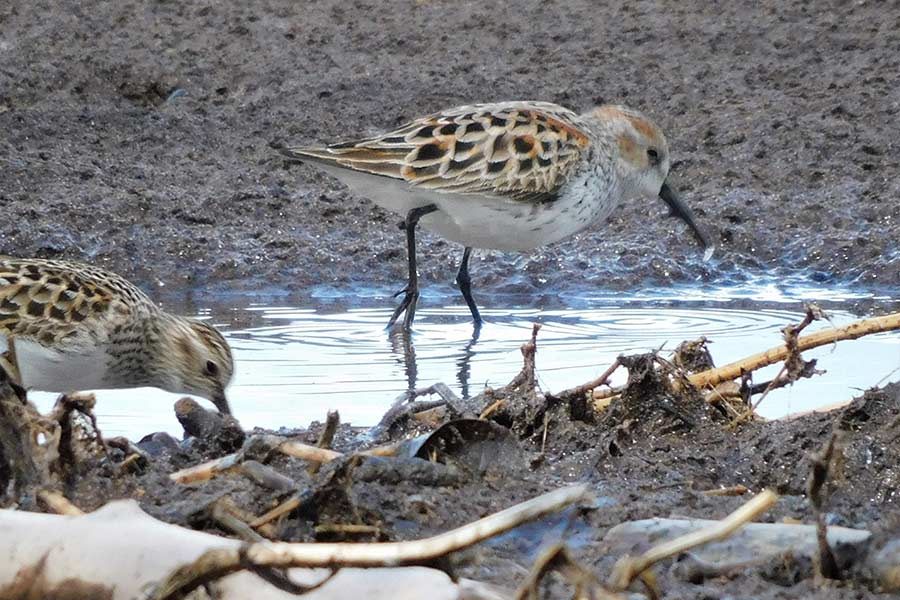Statewide shorebird surveys restarted after 30-year hiatus; over 84,000 shorebirds counted during spring survey
Salt Lake City — After the last formal shorebird surveys conducted more than 30 years ago across the Intermountain West, the Utah Division of Wildlife Resources, along with other wildlife focused organizations, revived monitoring to gather important data about migratory shorebirds at key sites across Utah.
Partners involved in the survey include the Utah Division of Wildlife Resources, Sageland Collaborative, the U.S. Fish and Wildlife Service, Tracy Aviary, National Audubon Society Audubon Chapters in Utah, Point Blue Conservation Science and many volunteers. A trial survey was conducted in Utah last fall, but this recent spring survey launched the official data collection for shorebirds in Utah as part of a larger migratory shorebird survey taking place at roughly 200 sites across 11 western states in the U.S.
The Utah spring survey was conducted from April 24–28, and partnering agencies recently finished compiling the results.
"The historic bird surveys we are replicating occurred nearly 30 years ago, so these surveys fill a critical three-decade data gap in our understanding of migratory shorebird populations and their distribution," National Audubon Society Engagement Manager Max Malmquist said. "Most importantly, the results of these surveys will inform management and policy efforts to ensure there are resources to support birds and the places they need during their migratory journeys across the Intermountain West."
During the spring survey, a total of 84,128 birds were counted at 69 specific sites at four different Utah waterbodies: Great Salt Lake, Utah Lake, Fish Springs National Wildlife Refuge and the Amalga Barrens Sanctuary. The survey was conducted by volunteers and biologists via airplane, vehicles, ATVs, boats and on foot.
"Over the course of five days, 115 participants surveyed for shorebirds across Utah," Sageland Collaborative's Communications Specialist and Project Coordinator Sierra Hastings said. "Without the dedication of our outstanding volunteers, these efforts would not be possible. We're so grateful for the expertise and passion that our volunteers bring to these surveys, and we're excited to continue counting shorebirds with them in the fall."
Some of the highlights of the spring survey include:
- Seeing 23 different species of migratory shorebirds.
- Counting 447 Snowy Plovers, which is a species of greatest conservation need.
- Seeing a few rare birds, including two Semipalmated Sandpipers, two Whimbrels and one Pectoral Sandpiper.
The most commonly counted birds during the survey were American Avocets, followed by Wilson's Phalaropes.
Great Salt Lake is the largest saline lake in the Western Hemisphere. The lake and its surrounding wetlands are home to 75% of all wetlands in Utah. Roughly 330 species of birds have been documented at Great Salt Lake and its surrounding wetlands and uplands throughout the years.
"Great Salt Lake is an incredibly dynamic ecosystem, and shorebirds adjust how they use the lake as their habitats shift through time," Utah Division of Wildlife Resources Great Salt Lake Ecosystem Program Wildlife Biologist John Neill said. "Lake level, surface area, salinity and vegetation change constantly throughout the year and over decades. One example of this shift in habitats is seen on the west side of the lake. Thirty years ago, no phalaropes were observed spread out along the shoreline during fall migration, but last fall, over 80,000 phalaropes were counted. Phalaropes were present 30 years ago, but they were utilizing different habitats. The large spring runoff reduced shorebird habitat this year by flooding many of the shallow water mudflats that shorebirds prefer, and vegetation that has encroached along the mudflats during recent low water level years became inundated with water, limiting the mudflat shoreline habitat for shorebirds."
This survey will be conducted for the next three years, during the same week each spring and fall, to coincide with the average peak shorebird migration across the region. While the number of birds counted this spring was lower than expected, biologists believe it is likely due to the prolonged winter delaying bird migrations in April when the survey was conducted.
People experienced in shorebird identification can sign up to help with the fall migratory shorebird survey on the Sageland Collaborative website. The fall survey will take place on Friday, Aug. 11. If inclement weather occurs, then the survey will be conducted on Aug.12.

















